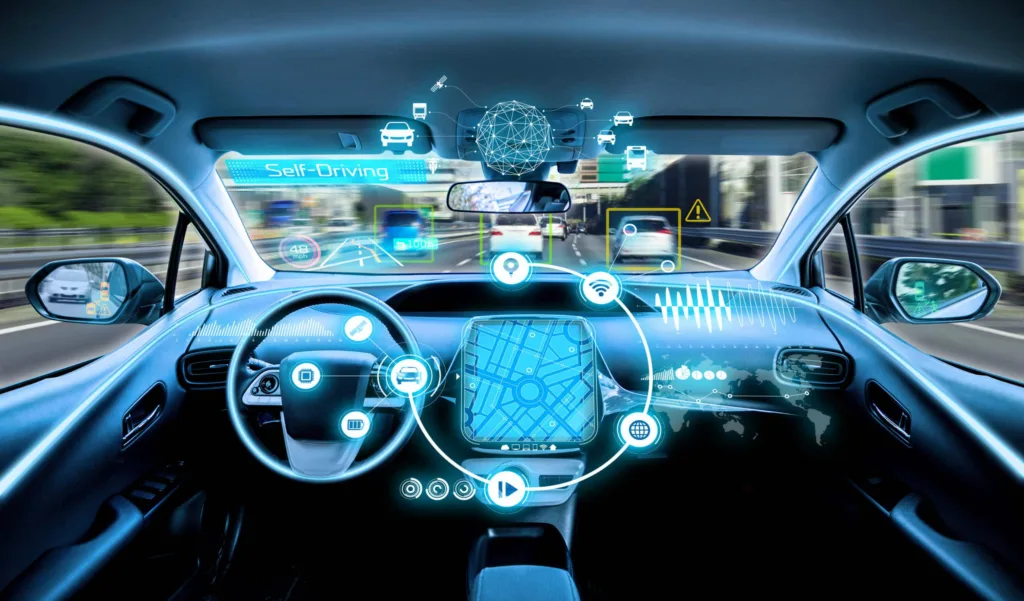Imagine a world where commutes are stress-free, traffic jams become relics of the past, and accidents are significantly reduced. This isn’t science fiction; it’s the potential future promised by autonomous vehicles, often called self-driving cars. These technologically advanced vehicles are poised to revolutionize transportation, offering a glimpse into a world where mobility is redefined.
But what exactly are autonomous vehicles? In essence, they are cars capable of navigating and operating without human input. Equipped with a suite of sensors, cameras, and powerful computing systems, they can perceive their surroundings, interpret traffic signals, and make decisions in real-time, mimicking the actions of a skilled driver.
A Symphony of Technology:
The inner workings of an autonomous vehicle are a fascinating dance of technology. Here’s a breakdown:
- Sensors: These are the eyes and ears of the car, gathering information from the environment. Radar detects nearby objects, LiDAR measures distances with laser pulses, and cameras capture visual data.
- High-definition maps: These act as digital roadmaps, providing precise information about lanes, intersections, and traffic patterns.
- Processing power: Powerful onboard computers analyze sensor data in real-time, identify potential hazards, and make driving decisions.
- Machine learning: This technology allows the car to continuously learn and adapt to its environment, improving its performance over time.
Levels of Autonomy:
Not all autonomous vehicles are created equal. They operate at different levels, defined by the Society of Automotive Engineers (SAE):
- Level 0 (No Automation): Human driver has complete control.
- Level 1 (Driver Assistance): Features like cruise control and lane departure warning assist the driver.
- Level 2 (Partial Automation): Systems like adaptive cruise control and lane centering can take over some driving tasks, but the driver must remain attentive and ready to intervene.
- Level 3 (Conditional Automation): The car can handle certain driving tasks in specific conditions, but the driver must be available to take over when prompted.
- Level 4 (High Automation): The car can operate autonomously in most situations, but human intervention may be needed in complex environments.
- Level 5 (Full Automation): The car can handle all driving tasks in all conditions, without any human input.
The Road Ahead: Opportunities and Challenges:
The potential benefits of autonomous vehicles are vast:
- Reduced accidents: By eliminating human error, autonomous vehicles could significantly reduce road accidents and fatalities.
- Improved traffic flow: Optimized driving patterns could lead to smoother traffic flow and reduced congestion.
- Increased accessibility: Autonomous vehicles could provide mobility solutions for people with disabilities or those who cannot drive themselves.
- Enhanced productivity: Time spent commuting could be used productively while the car handles the driving.
However, challenges remain:
- Safety concerns: Public trust in the safety of autonomous vehicles is crucial, and addressing ethical dilemmas related to accidents is essential.
- Regulation: Clear and comprehensive regulations are needed to ensure the safe and responsible deployment of autonomous vehicles.
- Infrastructure: Adapting existing infrastructure and developing new technologies to support autonomous vehicles is crucial.
The Future is Autonomous:
Despite the challenges, the potential of autonomous vehicles is undeniable. As technology advances and public acceptance grows, these vehicles are poised to reshape transportation, offering a glimpse into a safer, more efficient, and accessible future. Buckle up, the future of mobility is here, and it’s autonomous!
Additional Resources:
- Society of Automotive Engineers.
- National Highway Traffic Safety Administration.
- The World Economic Forum.
Remember, this is just the beginning of the autonomous vehicle revolution. Stay tuned for an exciting ride!
Frequently Asked Questions About Autonomous Vehicles:
Are autonomous vehicles safe?
Safety is paramount for autonomous vehicles. Extensive testing and stringent regulations are in place to ensure their reliability. While challenges remain, early tests and simulations show significant potential for accident reduction compared to human-driven vehicles.
When will self-driving cars be readily available?
The timeline for widespread adoption depends on various factors, including technological advancements, regulatory approvals, and public acceptance. Currently, Level 2 and 3 vehicles are commercially available, offering driver assistance features. Reaching Level 4 and 5 autonomy may take several years, with estimates ranging from 2025 to 2030.
Will autonomous vehicles eliminate jobs?
While some traditional driving jobs may be impacted, new opportunities will likely emerge in the development, maintenance, and operation of autonomous vehicles. Additionally, increased accessibility could create new jobs in sectors like transportation and logistics.
What about the ethical dilemmas of autonomous vehicles?
Complex ethical questions arise in situations where an autonomous vehicle needs to make difficult decisions. Ethical frameworks and legislation are being developed to address these challenges, focusing on safety, transparency, and accountability.
How will autonomous vehicles impact traffic and congestion?
Optimized driving patterns and communication between vehicles could significantly reduce traffic congestion. Additionally, increased ridership sharing options facilitated by autonomous vehicles could further improve traffic flow.
Conclusion
The world of autonomous vehicles is evolving rapidly, presenting both exciting opportunities and important challenges. By addressing concerns regarding safety, regulation, and ethics, we can pave the way for a future where autonomous vehicles revolutionize transportation, making it safer, more efficient, and accessible for everyone. The journey is underway, and the destination promises a transformative shift in how we move around the world. Stay curious, ask questions, and get ready to join the ride!



